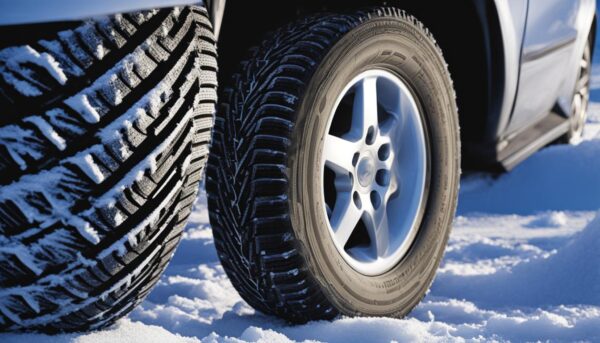Last Updated on 1 week
Unveiling the Truth About Snow Tires and All-Season Tires Performance
When it comes to winter driving, the debate between snow tires and all-season tires often arises. With a focus on providing better traction, improved stability, and enhanced stopping power, snow tires are specifically designed for harsh winter conditions. Meanwhile, all-season tires are created for versatility, making choosing the right tire confusing. In this article, we’ll dive into the differences between these two tire types and help you decide which is best for your driving needs and local climate conditions.
Key Takeaways:
- Snow tires offer superior traction and control in winter conditions.
- All-season tires are versatile and suitable for mild weather patterns.
- Advancements in winter tire technology, such as silica compounds and aggressive tread designs, contribute to better ice handling and performance.
- Investing in winter tires can be cost-effective in the long run, as they can potentially prevent accidents and extend the lifespan of all-season tires.
- Choosing the right tire should be based on driving habits, local climate conditions, and consultation with tire experts.
Understanding Tire Types: Snow Tires vs All-Season
When navigating the roads in winter, choosing the right tire for your vehicle is crucial. Snow tires, also called winter tires, are designed to deliver exceptional performance in winter conditions such as snow, rain, and ice. They use softer rubber compounds and tread designs optimized for cold weather.
In contrast, all-season tires are like the footwear equivalent of tennis shoes: versatile for various seasons but not specialized for extreme conditions. While they are quiet, durable, and provide performance in wet and light winter conditions, they fall short in offering the same grip and control as snow tires when faced with harsh winter weather.
“All-season tires are designed for comfort, durability, and fuel efficiency. Their tread patterns and rubber compounds are suitable for mild weather conditions. When it comes to more severe winter weather, snow tires provide superior traction, control, and safety.”
Let’s explore the differences between snow tires and all-season tires regarding tire technology and their performance in snowy conditions and moderate climates.
| Features | Winter Tires | All-Season Tires |
|---|---|---|
| Rubber Compound | Softer | Harder |
| Tread Design | Optimized for cold weather | General purpose |
| Siped Edges | More numerous | Fewer |
| Traction in Snow | Superior | Moderate |
| Control in Icy Conditions | Exceptional | Limited |
| Durability | Less than all-season tires | More than winter tires |
In summary, winter tires provide a higher level of performance in snowy and icy conditions compared to all-season tires. While all-season tires are a decent option for those living in moderate climates with less severe winter weather, it’s important to remember that they do not offer the same grip and control that snow tires afford during harsh winter conditions.
Innovations in Snow Tire Technology
Technological advancements in snow tire manufacturing have significantly improved traction, acceleration, and overall performance on winter roads. By incorporating advanced materials like silica compounds, innovative tread designs, and a higher density of sipes, winter tires outperform all-season tires under harsh weather conditions.
The Role of Silica and Other Compounds in Traction
One of the most notable developments in snow tire technology is the inclusion of silica compounds in the rubber composition. These compounds drastically enhance the tire’s flexibility and adhesion on icy surfaces. Softer rubber with silica materials stays pliable even in freezing temperatures, providing better traction and safety on winter roads than all-season tires.
Aggressive Tread Designs for Winter Roads
Tread design plays a major role in the performance of winter tires on snow and ice. In contrast to all-season tires, winter tires feature more aggressive and purpose-driven tread designs, like saw-tooth sipes and micro-pumps embedded within the tread. These cutting-edge treads maintain traction through efficient water management and biting into snow and slush, leading to better acceleration in slippery conditions.
Importance of Sipes in Winter Tire Performance
Sipes, the small cuts in the tire tread, are crucial to enhancing winter tire performance. A higher density of sipes in winter tires allows for more surface area contact, resulting in improved traction on snow and ice. Acting as a water squeegee sipe, it efficiently processes slush and snow, reducing the risk of hydroplaning and maintaining a superior grip on winter roads.
Winter tires are engineered with advanced materials, specially designed treads, and a high density of sipes, delivering exceptional performance in harsh winter conditions.
- Silica compounds enhance flexibility and adhesion on icy surfaces.
- Aggressive tread designs provide better traction and acceleration.
- Sipes function as water squeegees and reduce hydroplaning risk.
All-Season Tires: A Compromise for Mild Conditions
All-season tires are designed for comfort and versatility, offering a year-round solution for many drivers. With their less specialized tread patterns and moderately pliable rubber, these tires can deliver versatile performance in various conditions, including mildly cold winters and wet roads. However, they fail to excel in extreme winter conditions, such as heavy snowfall or icy roads.
All-season tires can be convenient for drivers living in moderate climates with infrequent bouts of severe winter weather. Hair-raising driving scenarios are less common in such locations, so many car owners may deem their limitations under harsh conditions tolerable.
But in areas where winter spells trouble – heavy snow, ice, and slush – all-season tires’ performance may falter. In cases like these, a more specialized tire set, such as dedicated winter tires, may be worth considering to ensure safety and driving confidence during the cold months.
For drivers with mild winter conditions, all-season tires offer a balance of versatility and adequate performance, but they may fall short under more extreme conditions.
- Moderate climates: All-season tires are best suited for where severe winter conditions occur less frequently. These types of tires better endure temperature fluctuations and mixed snow or rain days than extreme winter conditions.
- Mild winter conditions: The optimized performance they can deliver on slightly wet or moderately cold roads is impressive, but these tires may struggle when the weather turns more punishing.
- Year-round use: The convenience of using all-season tires throughout the year is indisputable. However, this may also mean car owners must trade off some superb performance under harsh, icy conditions.
In conclusion, all-season tires have their place in the market, primarily catering to less demanding environments or owners seeking a one-solution-fits-all tire set. These tires offer comfort, longevity, and moderate performance in multiple weather conditions. However, anyone facing extreme winter climates should be prepared to invest in dedicated winter tires to overcome their limitations, thus ensuring road safety and control.
Performance Comparison: Traction and Stability in Winter Conditions
When facing winter driving conditions, making the right tire choice becomes crucial for maintaining optimum safety and control on the road. In a direct comparison between snow tires and all-season tires, it becomes evident that snow tires offer significantly better traction and stability during winter months.
This difference arises from the specialized design and materials used in snow tires, which aid in achieving safer cornering, quicker acceleration on icy surfaces, and shorter stopping distances. All these factors play a vital role in avoiding accidents during winter conditions. This section will explore a performance comparison between snow tires and all-season tires, focusing on traction and stability.
“Snow tires offer significantly better traction and stability in winter conditions when pitted against all-season tires.”
- Cornering Abilities
- Acceleration on Icy Surfaces
- Stopping Distances
| Tire Type | Cornering Abilities | Acceleration on Icy Surfaces | Stopping Distances |
|---|---|---|---|
| Snow Tires | High | High | Short |
| All-Season Tires | Medium | Medium | Long |
As the table above demonstrates, snow tires provide clear advantages in all three performance metrics compared to all-season tires. The main reasons for these differences are the unique tread design and rubber compounds in snow tires, specifically engineered for harsh winter conditions. This specialized design contributes to overall driving safety during the cold months and gives drivers the confidence to tackle challenging road conditions.
In conclusion, considering the importance of traction and stability for maintaining control and safety during winter driving, snow tires undoubtedly outperform all-season tires. Investing in snow tires can significantly improve driving safety and peace of mind for those regularly encountering snow or ice on their roads.
Ice Handling: All-Season Tires vs Winter Tires
Ice handling is a crucial factor to consider when choosing between all-season and winter tires. In this context, ice handling refers to the tire’s ability to maintain grip on icy surfaces, helping improve vehicle control and safety.
Winter tires showcase superiority in ice handling due to their unique design and materials. The softer rubber compounds in winter tires help them remain pliable and maintain better grip even at low temperatures. Additionally, specialized tread designs allow winter tires to grip and effectively remove more water from the icy surface, ensuring better contact and traction.
On the other hand, all-season tires tend to harden in freezing temperatures, losing some of their ability to grip icy surfaces. This critical limit is associated with all-season tires, resulting in decreased performance and potentially compromising safety during snowy conditions.
Winter tires provide better grip, control, and safety on icy surfaces compared to all-season tires.
Let’s take a closer look at a comparison of winter and all-season tires’ ice-handling performance:
| Performance Aspect | Winter Tires | All-Season Tires |
|---|---|---|
| Softer Rubber Compounds | Yes | No |
| Remain Pliable at Low Temperatures | Yes | No |
| Specialized Tread Designs for Ice | Yes | No |
| Optimal Grip on Icy Surfaces | Yes | No |
| Effective Water Removal | Yes | Less Effective |
In conclusion, winter tires offer a clear performance advantage over all-season tires regarding ice handling. Drivers frequently encountering icy conditions should consider investing in winter tires to enhance control, grip, and overall road safety.
Winter Tire Features that Stand Out

While performance and safety are the primary attractions of winter tires, it’s crucial to understand the engineering behind them. Various winter tire features contribute to their superior performance and handling on snowy and icy roads. This section breaks down the three critical aspects that set winter tires apart: tread depth, rubber compounds, and siping.
- tread depth
Deeper tread depths on winter tires enable them to manage snow and slush effectively. The grooves dig into the snow, providing better traction and control, while the channels guide excess slush and water out from under the tires. These design characteristics ensure winter tires maintain a firm grip on slippery roads.
- Specialized Rubber Compounds
The rubber compounds used in winter tires have been specifically designed to remain flexible at low temperatures. This is vital for maintaining grip on icy surfaces, as it prevents the tires from hardening, which would otherwise reduce their traction. In contrast, the rubber compounds used in all-season tires tend to harden when exposed to freezing temperatures, making their grip less effective on slick winter roads.
- Siping
Siping refers to the small cuts or slits in a tire’s tread. Winter tires have a higher density of siping than all-season tires, which helps provide the additional traction necessary on icy roads. Sipes function as water squeegees, reducing hydroplaning risk and allowing for better handling of slush and snow.
In conclusion, combining these winter tire features allows them to outperform all-season tires in snowy and icy conditions. The specialized rubber compounds, deeper tread depths, and high density of siping work in unison to provide the superior grip, stability, and traction needed for safe winter driving.
Cost-Benefit Analysis of Investing in Winter Tires
Investing in a set of winter tires may seem like an expensive endeavor. Still, it is crucial to weigh the initial costs against the long-term savings, accident prevention, and overall benefits in terms of safety and performance. This comprehensive analysis provides a deeper insight into the financial advantages of owning winter tires.
Initial Costs and Long-Term Savings
While the upfront cost of winter tires can be considerable, the long-term savings eventually offset the initial investment. Rotating between winter tires and all-season tires each season results in an extended lifespan for both sets, reducing the need for constant replacement. Furthermore, using the appropriate set of tires for each season ensures optimal performance and less wear, which ultimately translates to even greater long-term savings.
Consider these financial benefits of winter tire investment:
- Extended lifespan of all-season tires
- Reduced wear and tear on both sets of tires
- A more cost-effective annual tire maintenance budget
Seasonal tire rotation allows you to get the most out of your tires, ensuring you enjoy the benefits they provide during the weather conditions without incurring extra costs.
Preventing Accidents and the Potential Savings
Another significant aspect of winter tire investment is the potential for accident prevention due to its superior handling and stopping capabilities. When considering the average collision deductible, winter tires can offset their cost in the event of a single accident, positioning them as a cost-effective safety measure.
According to the AAA, winter tires can reduce braking distance by up to 25% on snow and ice-covered roads, providing an essential safety benefit for drivers in regions with severe winter weather.
Moreover, avoiding accidents can save insurance by maintaining a clean driving record and potentially qualifying for a safe driver discount. Therefore, the benefits of investing in winter tires extend beyond the initial cost, offering substantial long-term financial advantages and enhanced safety for you and your vehicle.
| Benefits of Winter Tires | Impact on Insurance |
|---|---|
| Prevents accidents | Reduces insurance premiums and deductibles |
| Improves handling and stopping | Maintains a clean driving record and eligibility for safe driver discounts |
| Provides peace of mind during winter driving | Decreases risk factors for potential accidents, further securing lower insurance costs |
Overall, investing in winter tires is a matter of safety and a sound financial choice that rewards responsible drivers in the long run. Considering the initial costs, accident prevention opportunities, and potential insurance savings, it’s clear that the benefits of owning a set of winter tires far outweigh the expenses for those living in areas with harsh winter conditions.
Choosing the Right Snow Tires for Your Vehicle

Selecting the right snow tires is essential for enhancing your driving experience and safety during winter. With various options on the market, understanding your driving habits and climate-specific needs can help you make an informed decision. This section will guide you through the factors to consider when choosing snow tires for your vehicle.
Matching Tires to Your Driving Habits and Climate
The performance of your snow tires ultimately depends on the compatibility of their features with your driving habits and the local climate. Manufacturers produce different models to cater to specific wintery environments, so it is imperative to consult with tire experts and evaluate your driving requirements to ensure an appropriate match.
- Assess your driving habits: Reflect on the distance you typically travel, the types of terrain you encounter, and your daily commute during the winter season. You may need snow tires with enhanced grip and traction if you frequently drive on icy roads or gradients. Standard snow tires should be sufficient if your commutes are primarily through snow-plowed routes or urban areas.
- Analyze local climate conditions: Consider your region’s average temperature, snowfall, and ice conditions. In areas with extreme winter weather, selecting snow tires designed for severe cold, ice, and heavy snow is vital.
- Choose climate-specific tires: Once you understand your driving habits and winter weather conditions, pick the right snow tire model. Some popular options include:
| Tire Model | Best For |
|---|---|
| Bridgestone Blizzak WS90 | Heavy snow, ice, and slush |
| Michelin X-Ice Xi3 | Sub-zero temperatures, snow, and ice |
| Continental VikingContact 7 | Wet ice and mixed winter conditions |
| Pirelli Winter Sottozero 3 | Snow and cold-weather performance driving |
In conclusion, matching snow tires to your driving habits and regional climate conditions is crucial for achieving optimal performance and safety. Consult with tire experts and conduct thorough research to ensure an appropriate selection for your vehicle and winter driving needs.
Tips for Saving on Winter Tire Changeovers
While investing in winter tires is an essential safety measure for those who live in areas with harsh winter conditions, you can minimize expenses without compromising on quality and safety with the following saving tips:
- Invest in an extra set of wheels: Purchasing an additional set of wheels for your winter tires helps to avoid the need for expensive and time-consuming remounting and balancing each season. This move enables easier tire changeovers and allows your tires to last longer.
- Negotiate package deals with tire shops: When it’s time for your seasonal tire changeovers, try negotiating with tire retailers for package deals that may include tires, mounting, sensors, and seasonal tire storage. Cooperative negotiating tactics can often result in discounted prices.
In addition to these cost-saving steps, regular winter tire maintenance ensures optimum performance throughout the season while extending the lifespan of your tires. Utilize the following practices for effective care:
- Inspect tire pressure regularly, ideally once a month, as fluctuating temperatures can cause fluctuations in pressure.
- Rotate tires as needed, balancing wear and tear to maximize the longevity of all four tires.
- Consult your vehicle’s owner’s manual for specific tire care guidelines and recommendations.
By addressing potential setbacks upfront, you can minimize expenses and maintain the quality of your winter tire changeovers. Proper planning, strategic cost-saving measures, and regular maintenance can enhance your driving experience and safety during the year’s coldest months.
Making the Decision: When to Opt for Snow Tires
Deciding whether to invest in snow tires primarily depends on your region and the extent of winter weather you regularly encounter. For drivers who routinely face severe winter conditions, snow tires are essential for maintaining winter driving safety. These specialized tires offer superior traction and control for navigating snow and ice-covered roads. The decision to switch to winter tires varies based on regional climate and individual driving habits, but certain factors can provide guidance.
- Consider your local climate: Residents with frequent snow, ice, and extreme cold should opt for snow tires to ensure safe winter driving. Alternatively, all-season tires may suffice for those rarely experience harsh winter conditions.
- Assess your driving habits: Frequent winter travelers or those with long commuting distances may benefit even more from snow tires, as added tire grip and control significantly enhance safety and vehicle handling.
- Examine tire performance: Ultimately, the performance difference between snow tires and all-season tires in winter conditions should weigh heavily in your decision. Numerous tests confirm the marked superiority of snow tires in providing stability, shortening stopping distances, and improving traction on snow and ice.
“The superior traction and control offered by winter tires make them a vital safety component for frequent driving on snow and ice-covered roads.”
Given the advantages offered by snow tires, carefully evaluating your region’s climate and personal driving habits can help determine the best tire choice for your specific needs. Winter driving safety should be paramount in your decision-making process, as investing in the right tire solution can reduce the risk of accidents during the winter months.
Conclusion
Snow tires offer undeniable benefits over all-season tires for winter driving. Snow tires’ superior traction and control make them an essential safety component for navigating colder climates and hazardous conditions. While all-season tires may perform well in milder weather, drivers who regularly deal with harsh winter conditions should strongly consider snow tires as the recommended choice.
Before investing in snow tires, individuals should assess factors such as their driving habits, local climate, and the specific needs of their vehicle. For those who take the time to consult with tire experts and select the appropriate tire, snow tires’ performance advantages and accident prevention can prove invaluable.
Ultimately, making an informed decision on tire choice can significantly improve driver confidence and safety during winter. By understanding the key differences, performance benefits, and optimal applications for snow tires and all-season tires, motorists can better prepare themselves to face the challenges of winter driving.
FAQ
Are snow tires better than all-season tires?
Snow tires offer better traction, stability, and stopping power than all-season tires, particularly in snowy and icy conditions. They are designed for cold weather and winter road conditions, while all-season tires are designed for versatility in more moderate climates.
What are some innovations in snow tire technology?
Snow tire technology has made advancements in rubber compounds, including silica, contributing to improved road grip. Aggressive tread designs, sipes, and micropump holes help manage water and provide better acceleration and shorter stopping distances.
How do all-season tires compare to winter tires in mild conditions?
All-season tires are designed for versatility and comfort in moderate climates, including wet roads and mild winter driving without summer or winter performance extremes. They may provide adequate performance in more favorable winter conditions but fall short of the grip and control snow tires offer in more severe winter weather.
How do winter tires improve ice handling compared to all-season tires?
Winter tires have a distinct advantage in ice handling due to their softer rubber compounds and specialized tread designs, which grip and remove more water from icy surfaces. All-season tires tend to harden and provide less grip under the same conditions.
What are some cost-saving tips for winter tire changeovers?
Cost savings on winter tire changeovers can be achieved by investing in an extra set of wheels to avoid the need for remounting and balancing each season. Negotiating package deals with tire shops for tires, mounting, sensors, and seasonal storing can further reduce expenses.
How do I choose the right snow tires for my vehicle?
The correct winter tires should be based on your driving habits and local climate conditions. Consult with tire experts for tailored advice and choose from various models designed for specific wintery environments to find the right match for your vehicle and driving conditions.
When should I consider investing in snow tires?
Investing in snow tires is crucial for those living in areas with routine and severe winter weather. The superior traction and control offered by winter tires make them an essential safety component for frequent driving on snow and ice-covered roads.










